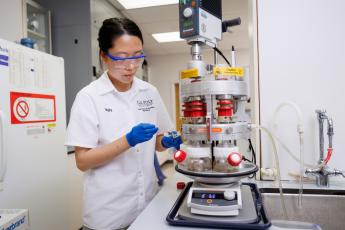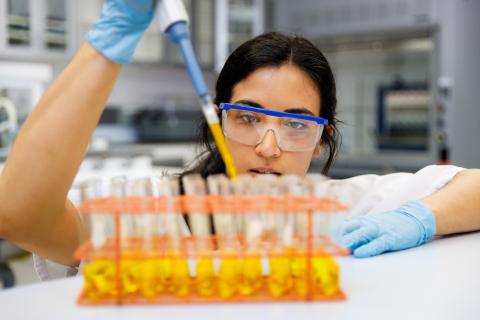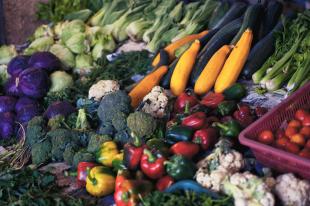All of the Olive: Cal Poly Researchers Explore Energy Potential in Food Waste

Could a new green energy source be hiding in our pantries? Food science graduate student Ningjing Hua and fourth-year food science student Kiveli Pandelidis are studying whether the waste from olive production could be used to make biomethane, a clean-burning energy source.
California produces nearly all of the nation’s olives, and more than half are used to make olive oil. But there’s a lot of waste left over: only about 20% of the olives’ mass becomes oil, and the other 80% of pulp, called pomace, is a waste product. Disposing of pomace means letting it ferment in landfills, which can cause bacterial contamination in water sources.
Beyond reducing that biowaste, Hua and Pandelidis hope that their study can determine whether it’s possible to maximize the methane yield of olive pomace for widespread commercial viability as an energy source.
“It's definitely good for the environment to use up this waste, but we’re not sure yet on the economical side,” says Hua.
Many energy-rich food crops, like corn, sugarcane and soybeans, are already commonly used as sources of biofuel, and the researchers started out already knowing that extracting similar fuel from olives is possible.
To find that maximum methane output, Hua tests a combination of different enzymes to break down the fibers in the olive pomace, transforming the mass into digestible sugars that can be readily consumed by bacteria and processed into methane. Pandelidis is then in charge of measuring the volume of those digestible sugars to determine how much methane can be produced, and therefore how much energy can be extracted.

For Pandelidis, who is also pursuing a minor in biotechnology, the project is an opportunity to develop skills and confidence in a lab setting as she prepares for grad school and a career goal of pushing the frontiers of lab-grown meat alternatives.
“It's all about being consistent and learning how to decrease the percentage of error going into the project,” she says. “All the science is really about decreasing variability and having a controlled environment.”
Even if olive biomethane fuel doesn’t take off on a massive scale, this project is yielding useful information on how olive producers can redirect their waste output into something more valuable. Many companies, notably some local beer breweries, already use their production waste to generate energy for their own operations on a small scale.
“If this process ends up becoming more of an upscaled manufacturing, that could really reduce the amount of food waste that we're putting out into the environment,” says Pandelidis. “It could turn into a more sustainable way of producing energy and not just from olives, but maybe with other foods that we haven't really tested yet.”
The study is part of a larger project working with the USDA and two other universities to maximize the use of olive pomace. Before the Cal Poly team gets its share of the pomace, researchers at UC Davis are working to extract phenolic compounds for use in antioxidant medicine. After Cal Poly is done, the remaining pomace goes to researchers at Virginia Tech, who are exploring its ability to transform into biochar, which can be used to absorb pollutants from water.
“It's a win-win process — if we do this, we can reduce the waste byproduct of the olive industry while also generating more clean energy for the state and for the world,” says Hua. “It's a whole cycle that can make the entire olive industry cleaner.”




